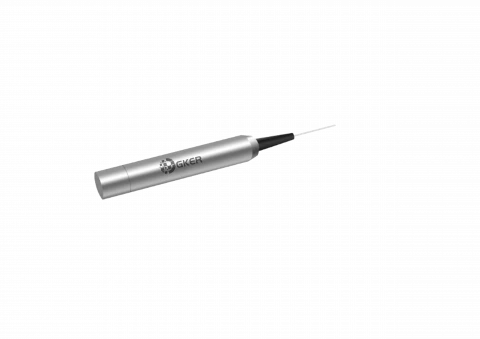1064 nm Polarization Maintaining Faraday Mirror
Description
The GKER Photonics 1064 nm Polarization Maintaining Faraday Mirror (GK-PMFM Series) is a specialized passive optical component designed to rotate the polarization of input light by 90 degrees. This rotation is crucial for minimizing polarization-related effects, making the PMFM an indispensable component in high-precision optical systems. Operating at a center wavelength of 1064 nm, it is ideally suited for applications in amplifiers, fiber lasers, and various fiber optic instruments where maintaining polarization is critical.
Engineered for superior performance, the GK-PMFM Series offers a typical insertion loss of just 2.8 dB, ensuring minimal signal degradation. The Faraday Mirror also features a minimum extinction ratio of 20 dB, which helps maintain the integrity of the polarization state throughout the system. The device is built with PM 980 Panda Fiber, known for its high polarization-maintaining capability, and can handle a maximum continuous wave optical power of 150 mW.
In addition to its high performance, the 1064 nm Polarization Maintaining Faraday Mirror is designed for excellent environmental stability, operating reliably within a temperature range of -5°C to +50°C. Its robust design, combined with low polarization-dependent loss and minimal polarization mode dispersion, ensures that this device provides consistent and reliable performance in even the most demanding optical applications.
1064 nm Polarization Maintaining Faraday Mirror
Specifications |
|
|---|---|
| Center Wavelength: | 1064 nm |
| Operating Wavelength Range: | 6 – 1064 nm |
| Typical Insertion Loss: | 2.8 dB |
| Max Insertion Loss: | 3 dB |
| Min Extinction Ratio: | 20 dB |
| Max Optical Power: | 150 mW |
| Center Wavelength (λc): | 1064 nm |
| Operating Wavelength Range: | λc ± 5 nm |
| Typ. Insertion Loss: | 2.8 dB |
| Max. Insertion Loss: | 3.0 dB |
| Faraday Rotation Angle (single Pass): | 45 degree |
| Max. Rotation Angle Tolerance, λc, 23 ℃: | ± 3 degree |
| Min. Extinction Ratio: | 20 dB |
| Fiber Type: | PM 980 Panda Fiber - |
| Max. Optical Power (Continuous Wave): | 150 mW |
| Max. Tensile Load: | 5 N |
| Operating Temperature: | - 5 to + 50 ℃ |
| Storage Temperature: | - 40 to + 85 ℃ |
Features
- Polarization Maintaining Design: Ensures precise polarization control with a 90-degree rotation angle
- Low Insertion Loss: Offers minimal signal loss with a typical insertion loss of 2.8 dB
- High Extinction Ratio: Maintains polarization integrity with a minimum extinction ratio of 20 dB
- Robust Fiber Construction: Utilizes PM 980 Panda Fiber for reliable polarization maintenance
- Excellent Environmental Stability: Operates effectively within a temperature range of -5°C to +50°C
Applications
- Fiber Amplifiers: Enhances the performance of fiber amplifiers by minimizing polarization effects
- Fiber Lasers: Ideal for maintaining polarization in high-precision fiber laser systems
- Optical Instruments: Ensures stable polarization in various fiber optic instrumentation
For pricing, technical or any other questions please contact the supplier
- No registration required
- No markups, no fees
- Direct contact with supplier
-
Ships from:
China
-
Sold by:
-
On FindLight:
since 2024
Frequently Asked Questions
It rotates the polarization of input light by 90 degrees to minimize polarization-related effects.
It is ideal for fiber amplifiers, fiber lasers, and optical instruments that require polarization maintenance.
The typical insertion loss is 2.8 dB, ensuring minimal signal degradation.
The device uses PM 980 Panda Fiber, known for its high polarization-maintaining capabilities.
The minimum extinction ratio is 20 dB, ensuring strong polarization integrity.
It can handle a maximum continuous wave optical power of 150 mW.
The Faraday Mirror operates effectively within a temperature range of -5°C to +50°C.
The Faraday rotation angle is 45 degrees with a maximum tolerance of ±3 degrees.
It is designed to operate reliably within a wide temperature range and has low polarization-dependent loss.
Yes, it can be customized with various connector types and fiber lengths as per specifications.

